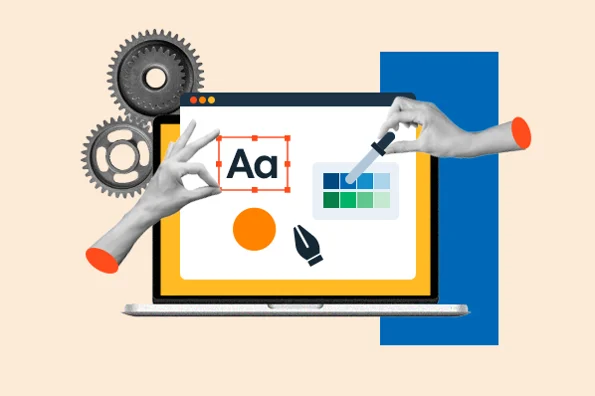How to design a website
Here’s a step-by-step guide to help you design a professional and user-friendly website:

Business: Designing a website can be a creative and rewarding process, but it requires careful planning and some knowledge of both design principles and web development tools.
Here’s a step-by-step guide to help you design a professional and user-friendly website:
1. Define Your Purpose and Goals
- Purpose: Decide on the website’s purpose. Is it for a personal blog, a business, a portfolio, an eCommerce store, etc.?
- Audience: Understand your target audience to tailor the design and content to their needs.
- Goals: Identify the primary goals, like generating leads, showcasing a portfolio, or providing information, and design with those goals in mind.
2. Plan Your Website Structure and Content
- Site Map: Outline the structure of the site (main pages like Home, About, Services, Blog, Contact, etc.).
- Content Strategy: Decide on the content needed for each page, including text, images, and multimedia.
- Wireframes: Create simple wireframes or sketches for each page layout to organize content and elements without getting bogged down by aesthetics.
3. Choose a Platform
- Code-Based Options: Use HTML, CSS, JavaScript, and frameworks like Bootstrap if you want full control and customization.
- Content Management Systems (CMS): Platforms like WordPress, Joomla, or Drupal allow you to build websites without extensive coding.
- Website Builders: Use platforms like Wix, Squarespace, or Webflow for easier drag-and-drop website creation.
- eCommerce-Specific: Use Shopify, WooCommerce (WordPress plugin), or BigCommerce for online stores.
4. Design the User Interface (UI)
- Select a Color Scheme: Choose a color palette that aligns with your brand or theme. Tools like Adobe Color can help.
- Typography: Choose easy-to-read fonts (typically sans-serif for web readability). Limit the number of fonts to two or three to maintain consistency.
- Images and Visuals: Use high-quality images or illustrations that relate to your content. Websites like Unsplash and Pexels offer free, high-resolution images.
- Layout and Grid System: Follow a grid layout to align elements neatly. This helps create balance and structure.
- White Space: Allow for breathing room between elements, making the site easier to navigate and visually appealing.
5. Prioritize User Experience (UX)
- Mobile Responsiveness: Make sure the website looks good on all screen sizes. Tools like Figma or Adobe XD allow you to preview mobile designs.
- Navigation: Ensure easy navigation by using a clear menu, well-defined headings, and a consistent page structure.
- Loading Speed: Optimize images, minimize code, and use caching plugins if on WordPress. Page speed is crucial for user retention and SEO.
- Accessibility: Design with accessibility in mind by using proper heading structures, alt text for images, and high-contrast color schemes for readability.
6. Develop the Website
- Code the Layout (if coding from scratch): Write HTML for the structure, CSS for styling, and JavaScript for any interactivity.
- Use Templates (for CMS or website builders): Many platforms offer customizable templates, making it easier to start with a strong design foundation.
- Customize & Add Functionality: Add plugins or widgets as needed, such as forms, social media buttons, or a blog feature.
7. Test Your Website
- Browser Compatibility: Test on multiple browsers (Chrome, Safari, Firefox, Edge) to ensure it works well everywhere.
- Device Responsiveness: Check on various devices (mobile, tablet, desktop) to confirm the layout adapts as expected.
- Load Speed Testing: Use tools like Google PageSpeed Insights or GTmetrix to measure load time and receive optimization suggestions.
- User Testing: Have friends or potential users browse the site to identify any issues or areas of improvement.
8. Optimize for Search Engines (SEO)
- Keywords: Research keywords relevant to your site’s content and incorporate them naturally.
- On-Page SEO: Use descriptive titles, headings (H1, H2, etc.), and meta descriptions for each page.
- Image Alt Text: Add relevant alt text to images, which helps search engines understand the content.
- Sitemap and Robots.txt: Create and submit a sitemap to Google for better indexing. You can do this in tools like Google Search Console.
- URL Structure: Use clean, descriptive URLs (e.g., “yoursite.com/contact-us” instead of “yoursite.com/pageid123”).
9. Launch and Maintain the Website
- Domain and Hosting: Purchase a domain name (like “yoursite.com”) and reliable hosting. Providers include Bluehost, SiteGround, and HostGator.
- SSL Certificate: Install an SSL certificate to secure your website (many hosts offer this for free), which improves security and SEO.
- Backup and Update Regularly: Back up your website and update plugins, themes, and CMS to keep it secure.
- Monitor Performance: Use tools like Google Analytics to track traffic and user behavior.
10. Continuous Improvement
- Content Updates: Keep your content fresh and relevant to improve engagement and ranking.
- A/B Testing: Experiment with design elements (like buttons, colors, or headlines) to see what performs best.
- SEO Optimization: Continue to optimize based on search trends, update keywords, and refine your SEO as search engines evolve.
By following these steps, you’ll be able to design a website that’s not only visually appealing but also effective and easy to use. Let me know if you need more specific guidance on any of these steps!
Do you have an advertisement or article you want to publisSh? Mail us at theugreports@gmail.com or WhatsApp +256394700683.






Whoa! This blog looks just like my old one! It’s on a totally different topic but it has pretty much the
same page layout and design. Wonderful choice of colors!